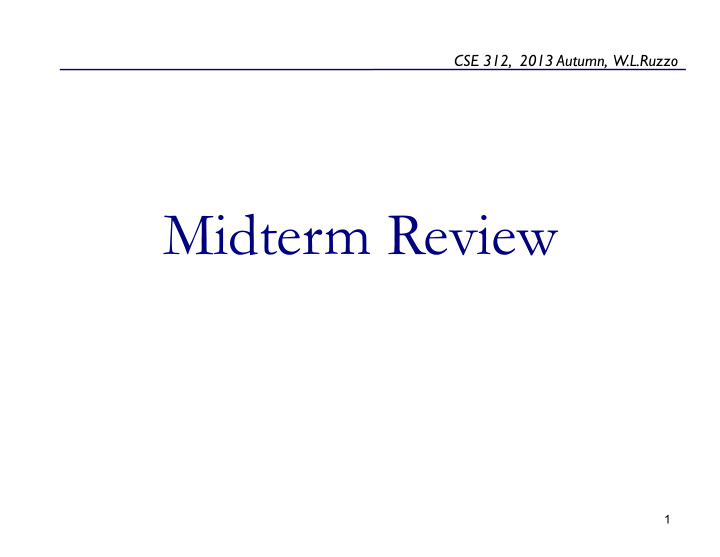



CSE 312, 2013 Autumn, W.L.Ruzzo Midterm Review 1
general coverage everything in text chapters 1-2, slides & homework pre-exam (except “continuous random variables,” possibly started today) is included, except as noted below. mechanics closed book; 1 page of notes (8.5 x 11, ≤ 2 sides, handwritten) I’m more interested in setup and method than in numerical answers, so concentrate on giving a clear approach, perhaps including a terse English outline of your reasoning. Corollary: calculators are probably irrelevant, but bring one to the exam if you want, just in case. 2
chapter 1: combinatorial analysis counting principle (product rule) permutations combinations indistinguishable objects binomial coefficients binomial theorem partitions & multinomial coefficients inclusion/exclusion pigeon hole principle 3
chapter 1: axioms of probability sample spaces & events axioms complements, Venn diagrams, deMorgan, mutually exclusive events, etc. equally likely outcomes 4
chapter 1: conditional probability and independence conditional probability chain rule, aka multiplication rule total probability theorem Bayes rule yes, learn the formula odds (and prior/posterior odds form of Bayes rule) independence conditional independence gambler’s ruin 5
chapter 2: random variables discrete random variables probability mass function (pmf) expectation of X expectation of g(X) (i.e., a function of an r.v.) linearity: expectation of X+Y and aX+b variance cumulative distribution function (cdf) cdf as sum of pmf from - ∞ independence; joint and marginal distributions important examples: know pmf, mean, variance of these bernoulli, binomial, poisson, geometric, uniform 6
some important (discrete) distributions E [ k 2 ] σ 2 PMF E [ k ] Name ( b − a +1) 2 − 1 1 a + b f ( k ) = ( b − a +1) , k = a, a + 1 , . . . , b Uniform( a, b ) 2 12 ( 1 − p if k = 0 Bernoulli( p ) f ( k ) = p p p (1 − p ) p if k = 1 � n � p k (1 − p ) n − k , k = 0 , 1 , . . . , n f ( k ) = np (1 − p ) Binomial( p, n ) np k f ( k ) = e − λ λ k k ! , k = 0 , 1 , . . . λ ( λ + 1) Poisson( λ ) λ λ 2 − p 1 − p f ( k ) = p (1 − p ) k − 1 , k = 1 , 2 , . . . 1 Geometric( p ) p 2 p 2 p ⇣ ( n − 1)( m − 1) f ( k ) = ( m k )( N − m Hypergeomet- n − k ) ⌘ nm nm + 1 − nm , k = 0 , 1 , . . . , N ( N N − 1 n ) N N N ric( n, N, m ) See also the summary in B&T following pg 528 7
math stuff Calculus is a prereq, but I’d suggest the most important parts to brush up on are: taylor’s series for e x sum of geometric series: Σ i ≥ 0 x i = 1/(1-x) (0 ≤ x<1) Tip: multiply both sides by (1-x) Σ i ≥ 1 ix i-1 = 1/(1-x) 2 Tip1: slide numbered 34 in “random variables” lecture notes, or text Tip2: if it were Σ i ≥ 1 ix i+1 , say, you could convert to the above form by dividing by x 2 etc.; 1st few terms may be exceptions integrals & derivatives of polynomials, e x ; chain rule for derivatives; integration by parts 8
Good Luck! 9
Recommend
More recommend